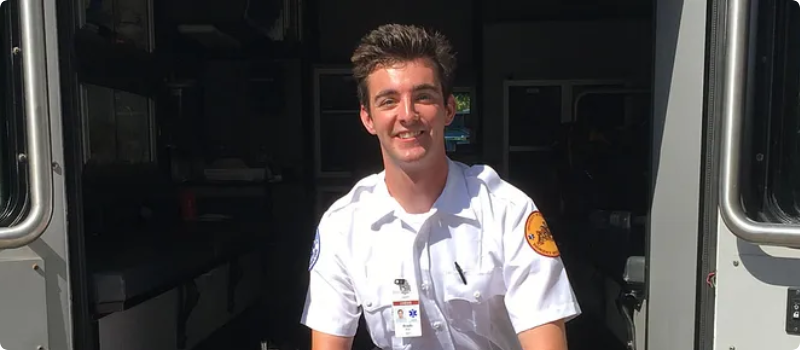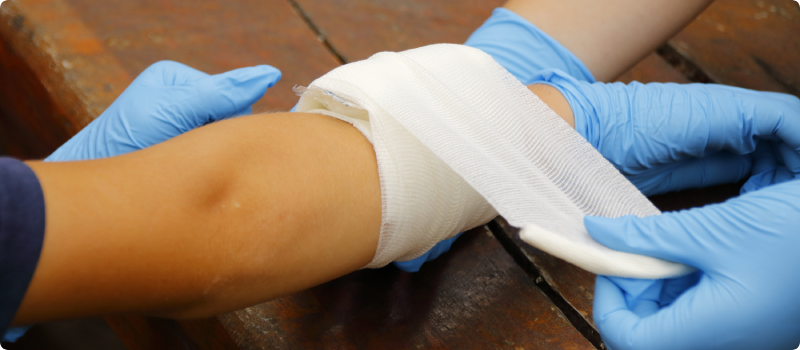What's a first-aid skill everyone should know?
Brady says, “CPR for sure. CPR is shown to be extremely effective if started within seconds to minutes. I think everyone should definitely have that skill.”
Updated June 14, 2024 . AmFam Team
Love helping people when they need it most — and not squeamish at the sight of blood?
Perhaps you’ve been considering volunteering as an EMT. Being a volunteer Emergency Medical Technician can be incredibly fulfilling on a personal level while allowing you to help out your community in a very direct and real way. Just take it from Brady Kutz, who works full-time as a quality assurance technician at American Family Insurance and volunteers as an EMT in his spare time.
Brady has been an EMT-Basic for over three years and typically volunteers anywhere from 24-36 hours a month — so when it comes to this field, he knows what it takes to succeed.
We sat down with Brady to learn more about the life of a volunteer EMT, from tips and key traits to be successful, training and certification, and much more. With the help of Brady’s firsthand experience, we’ll cover everything you need to know about being a volunteer EMT so you can decide if this dream pursuit is the right path for you!
As with any career quest, knowing if being an Emergency Medical Technician is a good fit for you is important. Are you interested in the medical field? Can you handle the pressure? You may never know until you try, but doing a bit of research first can help answer some of your questions and give you a boost in confidence to move forward.
If you’re considering becoming an EMT, Brady says it’s good to get into a medical environment and see how you like the vibe. He says your first step is to talk to other EMTs, “Go view a station and talk to an EMT — don’t be afraid to reach out to someone who has been in it for a while.”
Call your local station and see if you can look around and meet some EMTs and other first responders. While you won’t be able to go on an actual ride-along, you can come with a set of questions so you can pick their brains and understand what a day in the life of an EMT looks like.
Additionally, when considering if becoming an EMT is right for you, it’s helpful to ask yourself, “Why?” Are you passionate about helping your community? Are you intrinsically motivated to give back or make a difference in your area?
“Being an EMT is a great way to get involved — especially if you just want to volunteer,” Brady says. “You don’t become an EMT to get rich, but it’s a really good option if you want to get involved with your community on a more serious level.”
When pursuing any dream, it’s important to get a taste of what you’re getting into to know if it’s a good fit. Take the time to do this upfront work so you can go forward with confidence and purpose.
Thinking on your feet, performing well under high-stress situations and controlling your emotions. These are a few key traits Brady says you should have to be a successful EMT— that and have a strong stomach.
Sometimes, the EMT gets to be a hero. Whether it’s more critical, like getting someone to the hospital after a car wreck, or simply helping an elderly person get back into bed, your arrival brings a sense of peace of mind. But the title of hero comes with its own set of challenges. “The job isn’t always easy, and at times, I have to deliver bad news,” says Brady. “The things you see and smell can be rough, too. It can be very intense. You have to be able to push away your emotions and have a strong stomach and a strong mind.”
While it has its mental and physical challenges to overcome, being an EMT isn’t always intense and stressful, according to Brady. When you’re not on a call it can be laid-back and you’re able to relax at the station, sleep or workout. But as soon as a call comes in you need to switch your mentality to work mode — after all, you have to be on the road in three minutes or less.
Brady noted that he had a mentor who told him things should always get calmer when you get there, and if they don’t, you have a problem. Bringing that sense of calmness and composure to a stressful situation is one of the main reasons he enjoys volunteering as an EMT.
“My favorite part about volunteering is the look on someone’s face when you get there because you know what to do. They know you’re there to take care of them.”
Be able to…

Whether you’re planning to volunteer or to find a paid Emergency Medical Technician position, you’ll be required to complete a training course and receive certification. But how long will it take? Where can you take classes? Can you afford the class? Brady helped us answer some of the most common questions people have about how to become a volunteer EMT.
It’s important to note that we’re detailing the steps it’ll take to specifically become an EMT-Basic. Training for other Emergency Medical Services (EMS) positions, like Advanced EMT or Paramedic, requires its own set of coursework and exams.
To qualify to enroll in an EMT training program in the United States, you’ll usually need to fulfill the following requirements:
Requirements can vary by state and program, so be sure to check out your state’s specific training requirements.
EMT courses are typically offered at community colleges or technical schools. Brady advises, “Do some research at your local community colleges. Healthcare centers might offer classes, too. Do a quick search of EMT training in your area to see what’s available for you. Don’t be afraid to look out there."

Good news! You don’t have to spend years in school to become a certified EMT. In fact, like Brady, you can complete your courses in as short as eight weeks. Since Brady took the streamlined track, he went to class eight hours a day, two days a week, for eight weeks. Semester-long courses are available for those who don’t want to pack 120 to 150 hours worth of courses in just two months, which is the average amount of hours you may spend in the classroom.
After you’ve completed your in-class hours of coursework, it’s time to get face-to-face with patients. Brady says you’ll be required to see ten patients to complete your training. This is an opportunity to observe, learn and react in real time.
“I went into the hospital and was paired up with a nurse,” Brady says. “We’d go in and see the patients together, and I'd take their vitals and ask them questions.”
You can also do ride alongs if you prefer to get right in the action. “There are some things you can't do on these calls,” says Brady, “but you’ll ride along with a crew and when you get a patient, you go on scene with them, take vitals and ask questions.
Brady also mentioned that most schools will help you schedule your ride alongs or help you set up patient visits elsewhere. Don’t be afraid to ask for help while pursuing your dream. The right support can give you that boost you need to get you on the fast-track to success!
The cost of an EMT course varies depending on where you go, but it usually ranges anywhere from $800 to $2,000. Brady says he paid around $1,200, which included the cost of his class, books, uniform and final test at the end of the course.
Since EMT-Basic classes are completed over such a short amount of time, a lot of information is crammed into the length of your course. So be prepared to put in a lot of effort. As Brady says, “It’s only a semester, so work your butt off."
What does an EMT-Basic course load look like? You can typically expect to learn the following:
During your coursework, you’ll have plenty of time to get familiar with the equipment and practicing patient assessments during mock emergency situations.
Brady says, “A lot of the class is mock scenarios. You'll learn a skill, practice, learn more skills, and put them all together in a mock emergency."
Since you’ll be doing a lot of repetitive training, when it comes time for the real deal, you’ll be more confident in your abilities and be able to rely on what you know.
Brady says, “CPR for sure. CPR is shown to be extremely effective if started within seconds to minutes. I think everyone should definitely have that skill.”
Once you’ve completed your coursework, you’ll need to take the nationwide examination.
“The whole class is designed to help you train for this exam,” Brady says. So be confident that your training — plus some hardcore studying — will prepare you for success.
You’ll take your exam through the National Registry of Emergency Medical Technicians (NREMT), which is two parts:
1. Cognitive Exam. First, you’ll take the cognitive exam, which is done on the computer and consists of anywhere from 70 to 140 questions, depending on how well you do. The test will cover all the subjects you’ll need to know to be an effective EMT.
2. Psychomotor Exam. Once you pass the cognitive exam, you’ll then take the psychomotor exam, which is a more hands-on assessment of what you learned.
For this part of the exam, Brady says, “There were different stations set up and we got called in one by one. There was a CPR/cardiac arrest station, a splinting station and an advanced airway station. I had to stick a tube down someone’s throat — like that kind of thing.” Basically, this portion is testing a variety of procedures an EMT should be familiar with.
Once you pass the national tests, you can go to your state’s EMS website and fill out an application to be recognized by the state. Some states may have additional exam requirements, so be sure to check your state’s specific regulations.
You’ve passed your exams and are now officially an EMT — congrats! All that hard work has paid off. Keep the momentum going and start looking for places to volunteer.
“EMTs are always going to be in demand,” Brady says, “you can find jobs if you put in the effort and do your research.”
Like any job pursuit, build a resume that showcases your dedication and hard work towards your dream — with experience, unique skills and volunteer hours included!
To get started on your volunteer EMT job search, Brady says to look for volunteer EMS departments in your town. You can also simply hop online and do a Google search for volunteer EMT positions. Check out VolunteerEMS.org, where you can enter your job title and location to find volunteer EMT positions near you. Look at opportunities in your area, review the application process and consider the requirements. The more you become familiar with the process, the more successful you’ll be in finding a job.
When Brady was in college, he did a quick search on Indeed.com and found a position for a shift safety leader at a ski hill. He eventually found another paying gig with a local collegiate summer league baseball team. Brady says it’s not uncommon for smaller sporting teams or events to ask for volunteer EMTs. If you’re interested in those types of opportunities, keep in mind there are options out there that aren’t just in a station or hospital.
To keep your skills sharp, you’re required to renew your EMT certification every two years — even as a volunteer. In order to renew, you’ll need to take 40 hours of continued education courses within that two-year timeframe. Note that this soon may change to 60 hours every three years instead.
“My station offers a 2- to 3-hour training class once a month, which is extremely common with most services,” Brady says. “There are certain topics you have to hit, so they make sure that they’re rotating through them.”
So, whether it be through the station you work at or a class through a hospital, you’ll have options to cover your mandatory training.
As an EMT-Basic, there’s a lot of room to work your way up as a first responder. You can continue your training and education to become an Advanced EMT, which is more advanced than the Basic, or become a paramedic, which is one of the most advanced of the first responders.
Brady points out, “With EMS, there’s always learning to be done.”
Being able to make your way up as an EMT gives you purpose and the opportunity to work towards a new goal.

According to the National Registry of Emergency Medical Technicians, roughly 50 percent of EMT-Basics are volunteers. Supporting local heroes like volunteer first responders is a way to show that you value the work they do. And it doesn’t take much! Brady has a few simple suggestions for supporting EMS in your community:
Although Brady says, “We don’t want or need anything — we’re always here to do our job because it’s what we like to do,” showing appreciation in small ways goes a long way.
When asked what the biggest life lesson he’s learned since becoming a volunteer EMT, Brady says, “I’ve definitely become a very non-judgmental person. As an EMT, you help people from all ethnicities, backgrounds, ages and genders. It’s broadened my horizons, made me a diverse thinker, and makes me appreciate where I’m from and where I’m at now.”
If you’re looking to pursue a dream outside your full-time job, Brady says, “Try different things. Something will click. You never know what might guide you to something you enjoy.”
According to Brady, research is something he always starts with. “Dig into it. Put an hour on your calendar to research something you’ve always wanted to do. Reach out to people. People love talking about what they do and sharing their passions with other people. Someday, hopefully, that’ll be you sharing and giving back.”
He also says to lean on your support networks. While that may look different for everyone, having people in your life who support you and push you to take that step is a key element of fruitfully pursuing a dream.
Becoming an EMT is a noble pursuit — one that’s not for the faint of heart. But pursuing any dream takes hard work and ambition. Don’t let the fear of failure stop you from taking the leap. At the end of the day, it’s about finding passion in your life and doing something that fulfills you. As Brady points out, “We’re not all perfect. That’s why you have your partners. That’s why you have your training.”
At American Family, we’re dedicated to cheering on your dream pursuit. We’ve got a collection of articles that’ll help you along your journey, as well as stories of other dreamers like you. Check out inspiring and motivating stories for more ways you can make a difference.
This article is for informational purposes only and based on information that is widely available. We believe this information is accurate but do not make any guarantees or promise any results based on this information. We are not responsible for the content of any third-party sites that may be linked in this article.